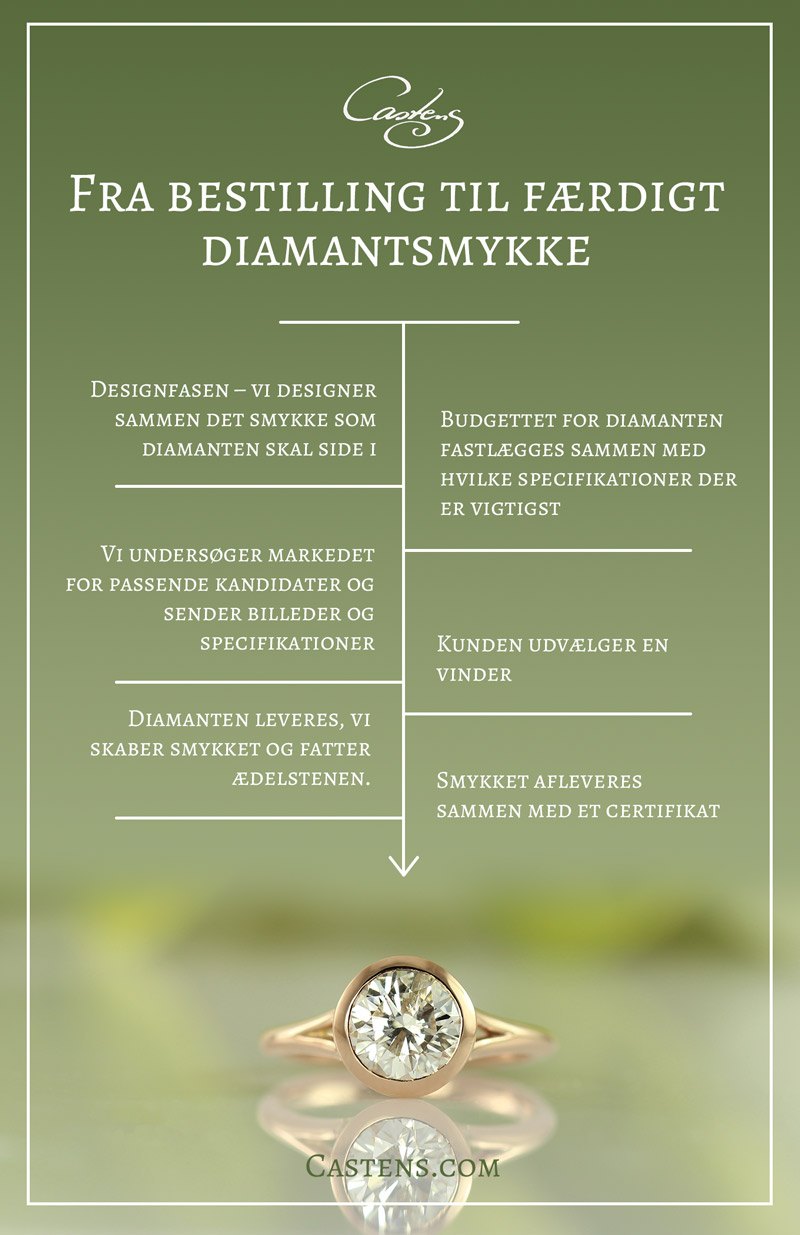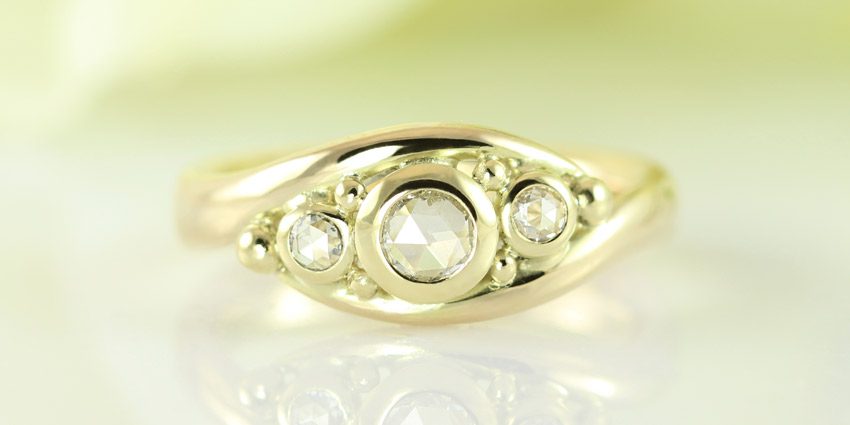Vælg den rette diamant
Det tankevækkende ved diamanter er, at de er skabt til evigheden: Længe efter vi er borte, vil diamanten stadig eksistere, og derfor ejer vi aldrig en diamant - vi passer bare på den for næste generation. Hvis du ønsker at købe en sådan diamant, skal du tage stilling til de 4 C'er, som beskriver diamantens kvalitet. Disse gør det meget nemmere at vælge den rette diamant i forhold til dine ønsker
Carat
Hvor stor er den? Dette er vigtigt i mange forhold og også når det kommer til diamanter. Der bliver fundet mange bittesmå diamanter og derfor er de indenfor rækkevidde for de allerfleste. Store diamanter – fra en carat og opefter er meget sjældnere i smykkekvalitet. Og virkeligt store diamanter er ekstremt sjældne - derfor vækker det altid stor opmærksomhed, når der bliver fundet nye kæmpediamanter, som fx Lesedi La Rona damanten på 1.109 carat, der blev fundet i Botswana for ikke så lang tid siden.
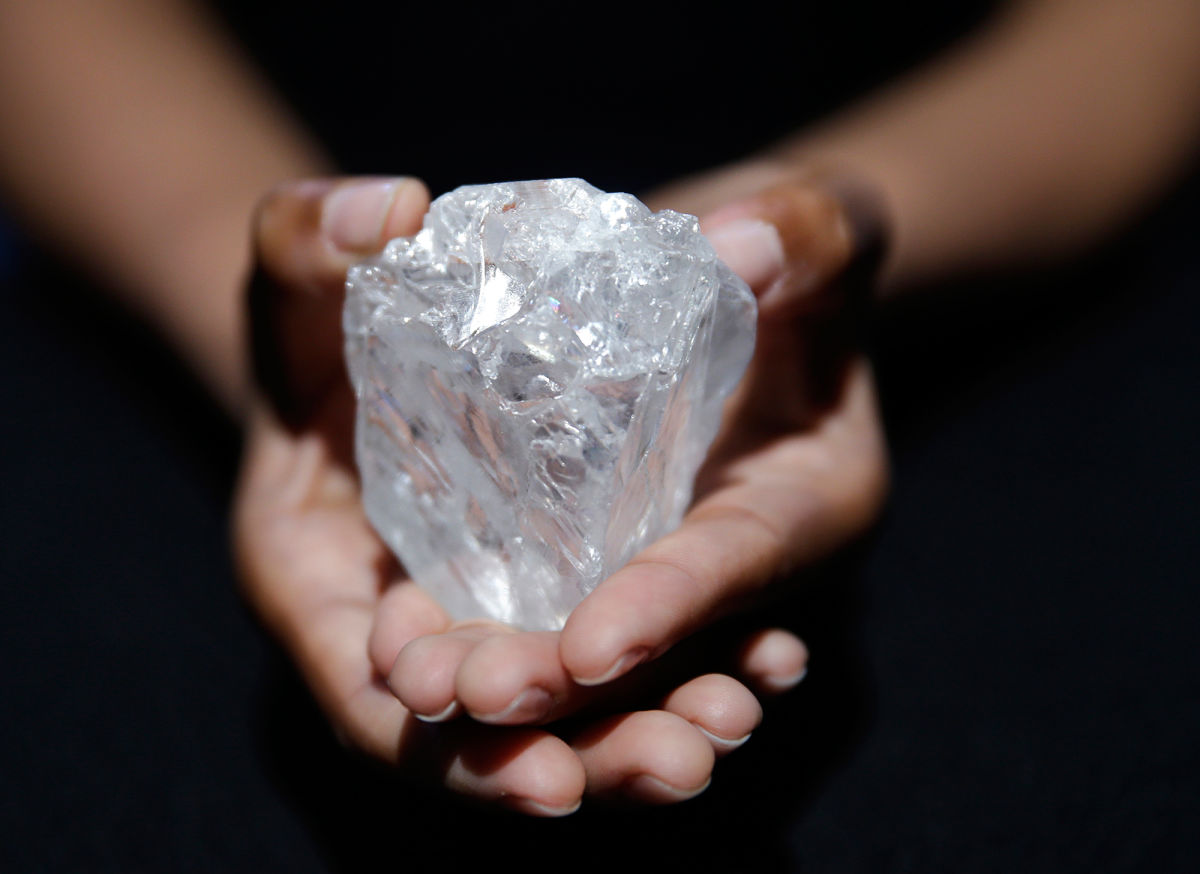
”Carat” er faktisk ikke en størrelse, men en vægtangivelse, hvilket kan være meget forvirrende. En carat svarer til 0,2 gram. Vi måler diamanter i "carat" med C og lødigheden af guld i "karat" med K. For at forvirre yderligere, kalder mange i branchen enheden 0,01 carat for ”one point”. En diamant på 0,23 carat betegnes derfor som 23 points.
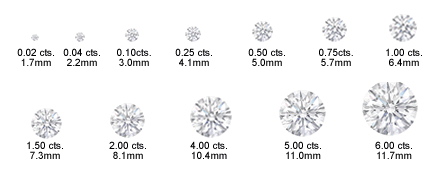
Clarity
Hvor klar er diamanten? Når vi taler om ”diamanter i smykkekvalitet” mener vi klare diamanter – altså sten man kan se igennem. Langt de fleste sten har naturlige indeslutninger i sig, og derfor er de HELT klare uden nogle indeslutninger overhovedet ret sjældne, og ikke så overraskende - dyre. Men her er der i høj grad tale om nuancer. Vi graduerer fra P for piqué (også kaldet I for "included"), hvor der er tydelige og store indeslutninger – lidt ligesom de fine flager i rav – til "Flawless" eller Lup-ren som er netop det: Selv hvis du benytter en stærk 10x lup kan du ikke finde nogen indeslutninger.
Det betyder i praksis, at en SI (som betyder Slightly included) stadig kræver en lup for at man kan få øje på urenhederne. Det siger sig selv, at for det blotte øje, og særligt hvis stenen er meget lille, virker en sådan sten klar. I butikken arbejder vi som udgangspunkt med SI (slightly included) diamanter til sølvsmykker, og mindst VS eller VVS til guldsmykker, medmindre vores kunder beder om noget andet.
I øvrigt har der i de senere år bredt sig en trend med opakke diamanter – altså diamanter, der har så mange indeslutninger, at de forekommer ugennemsigtige. Disse har ofte nogle smukke, underspillede jordfarver og et meget fint spil i overfladen – det ER jo diamanter. Det, der adskiller disse diamanter fra deres klare søstre er, at de er absolut individuelle: Ikke to er ens, og det er jo en charme, at de har lige så meget personlighed som vi mennesker.

Colour
Når vi tænker diamanter, tænker vi på ”hvide diamanter”. Det er naturligvis vrøvl, fordi de er ikke hvide, men farveløse, så hvad vi i virkeligheden taler om er, HVOR farveløse de er. Rigtig mange fine diamanter i smykkekvalitet har nemlig en mere eller mindre gullig tanke, og det er den, der refereres til i farveskemaet. I Danmark og en række andre lande hedder fine, hvide smykkediamanter ofte noget med ”Wesselton” – forkortet til W. Derudover supplerer vi med en alfabetisk inddeling, som også bruges internationalt:
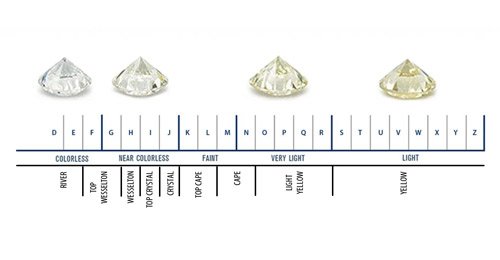
Mange diamanter findes i nuancer fra champagne til brunt, og disser farver kan være ualmindeligt charmerende , samtidig med at de ofte er en smule blidere ved budgettet. Når jeg bestiller champagnefarvede diamanter, er det som oftest farven C2, hvor jeg ville betegne C5 som "cognac".

Du kan også få diamanter med alle regnbuens farver. Mere herom længere nede.
Cut
Hvordan er diamanten slebet? Lige for at opklare en gængs misforståelse: en brilliant er ikke en særlig slags diamant. Det er en diamant, der har fået det vi kalder for en ”brilliantslib” – altså den helt klassiske, runde facetterede slib, vi forbinder med diamanter. Denne slib er den moderne slib med hele 57 facetter (også på de bittesmå 0,005 ct diamanter, som kun måler 1 mm). De fleste smykkesten slibes også som brilliantslib - men så er de bare "facetterede".

Slibningen er den eneste faktor, som vi mennesker har indflydelse på, og her er særligt de belgiske stenslibere dygtige. For hvis diamanten er proportioneret korrekt, og facetterne sidder rigtigt i forhold til hinanden, vil stenen reflektere næsten al lys tilbage igen indefra. Det er altså slibningen, der fremhæver diamanternes berømte ”ild”.
Lykkedes denne slibning helt perfekt opnår man det, som kaldes hearts & arrows. Dette kan ses, hvis man lægger den løse sten ind i et særligt rør og kigger igennem. Vi har et sådant i butikken og har du en løs diamant, er du velkommen til at komme ind og få tjekket, som det drejer sig om en "Hearts & Arrows".

Slibningen er så afgørende, at selv en W/SI kan overståle en River/FL, hvis slibningen er helt perfekt. Så bliver hvad man vil betegne som en god mellemkvalitet nemlig fuldstændig bjergtagende.
Vores primære diamantleverandør er PURE Diamonds, som har specialiseret sig i diamanter af særligt høj kvalitet. Det lille firma kan levere selv helt små diamanter i excellent cut, og endda i Hearts & Arrows, som jo også betegnes som ’Ideal Cut’ – til den kræsne feinschmecker!
PURE Diamonds har desuden som eneste danske diamantleverandør opnået den ære og tillid at blive optaget i Antwerp Diamond Bourse - et nærmest loge-agtigt selskab, som det er ualmindeligt svært at blive medlem af. Beurs Voor Diamanthandel er en af verdens ældste og mest prestigefyldte diamantbørser, hvilket garanterer seriøsitet, professionalisme, dybdegående branchekendskab samt efterlevelse af den højeste etiske standard.
Uover den runde form fås diamanter også i alle mulige andre former og facetteringer, fx de meget charmerende, gammeldags udseende rosenslib.
Vil du vide lidt mere om diamanter og fx se nogle fine eksempler på, hvordan de forskellige slib ser ud, så gå til GIA’s (Gemmologcal Institute of America) side.
Hvad koster en diamant?
Et svært spørgsmål! Det afhænger især af størrelsen, men, som ovenfor beskrevet, er der også andre kriterier, der spiller ind. En ganske lille diamant på fx 0,01 ct ( ca. 1,5 mm) - det, som mange i branchen lidt arrogant kalder for ”grus” - kan du få sat i dine smykker for under 500 kr (inclusive selve fattearbejdet).
Men priskurven er stejl!
Eksempel: En 0,1 carat diamant på ca. 3 mm, er en fin sten til en vielsesring. Den er til at få øje på, men stadig til at betale. I den såkaldt ”lave” ende af kvalitetsskalaen, koster en W/SI ca. 2.522 kr. Skal det være den bedste TW/VVS kvalitet, koster den ca. 3.342 kr. Til sammenligning vil den samme sten i en smuk, dæmpet champagne koste ca. 1000 kr.
Et andet eksempel på en større diamant:
En 0,34 carat diamant på ca. 4,5 mm koster i kvaliteten W/SI ca. 15.800 kr. I den bedste TW/VVS kvalitet koster den ca. 22.700 kr. Til sammenligning vil en elegant champagnefarvet version koste omkring 4.800 kr.
Hvad så med de helt store diamanter? En carat og opefter?
Topkvalitet (TW/VVS) står omkring 135.000 kr.
En farveløs diamant (W/SI2 - dvs. med enkelte urenheder, der kan ses med det blotte øje) koster lige under 80.000 kr.
Skal den være champagnefarvet, står den i ca. 24.000 kr.
En sort diamant til de dramatiske fås for under. 10.000 kr.
Når vi skriver "Topkvalitet" taler vi om den bedste kvalitet i en normal guldsmedje. Men det er jo ikke TOPkvalitet, fordi der (som du har læst ovenfor) findes endnu finere diamanter, nemlig farven "River" og kvaliteten "Flawless". Disse sten er så sjældne, at det er svært at prissætte dem, fordi prisen helt afhænger af, hvor mange af den slags diamanter der pt. findes på markedet.
Farvede diamanter
Vil du have en farvet diamant? Diamanter findes i alle regnbuens spektrum i naturen, men de er sjældne og derfor også relativt kostbare. Blå diamanter er allersjældnest og virkeligt kostbare og ses derfor kun meget sjældent i handelen. En halv carat naturligt blå diamant vil koste i omegnen af en million kroner!
De berømte pink Argyle diamanter, som stammer fra Argyle minen i Australien, findes i en vifte af smukke lyserøde nuancer, som er mere eller mindre sjældne og attråværdige.
En 0,1 carat naturlig Argyle diamant starter på omkring 29.000 kr for den mindst attråværdige farve, og fordobles eller triples endda, hvis farven bliver mere intenst lyserød. Priskurven i forhold til størrelse på Argyle diamanter er derfor også stejlere, end på de hvide diamanter.
Læs mere om, hvorfor de kostbare Argyle diamanter er så populære her
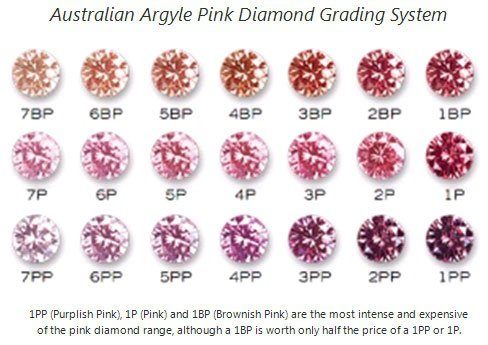
Men diamanter fås faktisk i mange helt vidunderlige farver, som er opnået, ved at man har kopieret den proces, der i naturen har farvet stenene, som oftest en radioaktiv bestråling, bombardering med atomer, pres eller varme. Disse ægte diamanter med en kunstigt opnået farve, er prismæssigt langt mere tilgængelige. MEN hvis du afleverer en ring til reperation, som har en farvet diamant, er det vigtigt at du oplyser guldsmeden om det - diamanten kan nemlig skifte eller miste farven ved den stærke varmepåvirkning en lodning er. Det kan vi modvirke på forskellig vis, men det er dit ansvar at gøre guldsmeden opmærksom på stenens karakter.
Eksempel på farvede diamanter: En olivenfarvet 0,1 carat diamant vil således koste ca. 1.730 kr, mens en lyserød stadig er dyrere. Den koster ca. 4.430 kr. Sorte diamanter er til gengæld meget mere opnåelige til en ca. pris af ca. 590 kr.
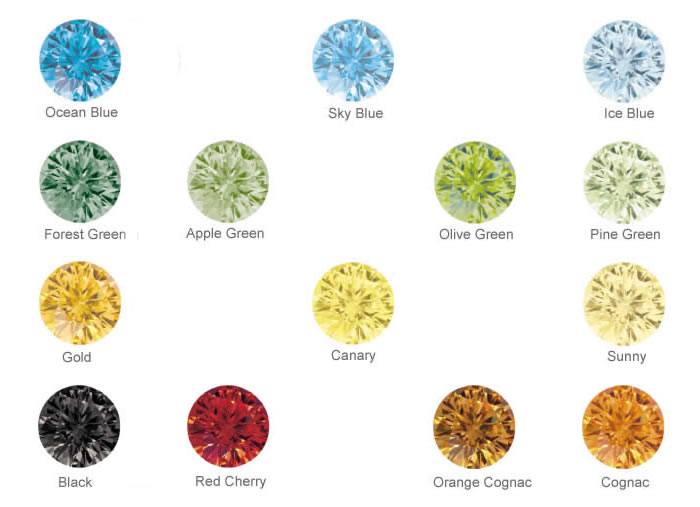
Overvej et budget
Der er altså diamanter at få for enhver pengepung, og derfor er det som regel en god ide at have et budget at arbejde ud fra, når vi skal skabe et smykke til dig. Vi plejer at give et bud på, hvad selve smykket – altså materialer og arbejdstid – koster, og så ser vi på, hvor meget sten vi kan få indenfor rammerne af dit budget. Der kan altid justeres på størrelser og kvalitet, så vi rammer lige præcist dit drømmesmykke!
Skal du have en lidt speciel sten i en særlig form, farve eller størrelse, går vi ud og afsøger markedet blandt vores leverandører, før vi kan give dig valget mellem en række forskellige sten, der matcher dine ønsker og budget.
Vil du lære endnu mere om diamanter, kan vi anbefale at gå på jagt efter den danske smykkeekspert par excellence Nina Halds bøger om emnet.
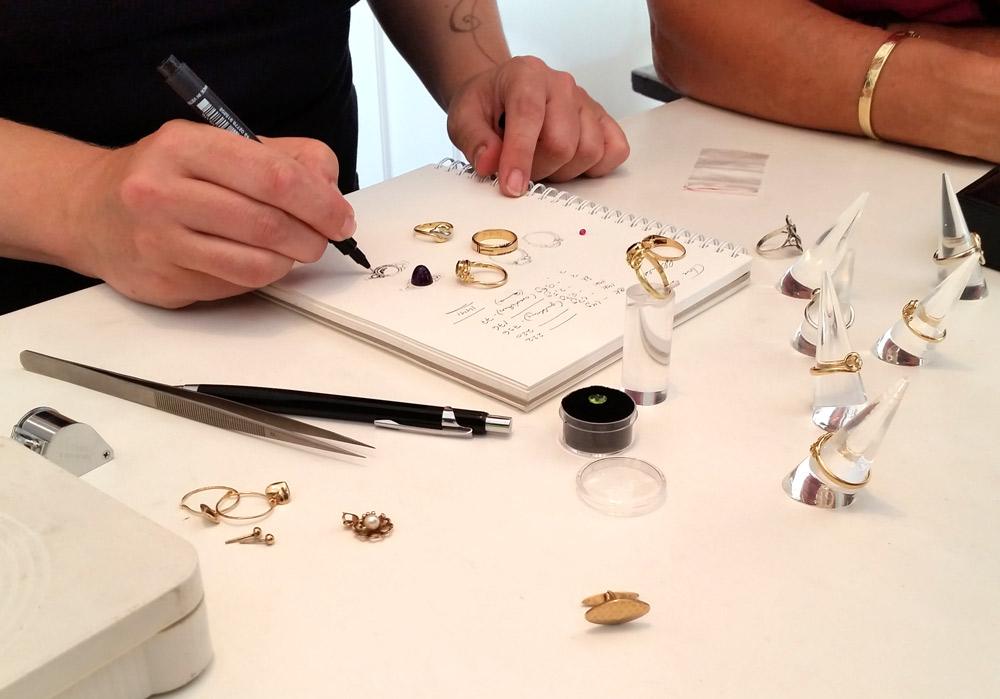
OBS! Ovenstående priser er vejledende og flukturerer med dagspriserne.
Ønsker du at få et prisestimat på din drømmediamant, er du velkommen til at kontakte os på design@castens.com
